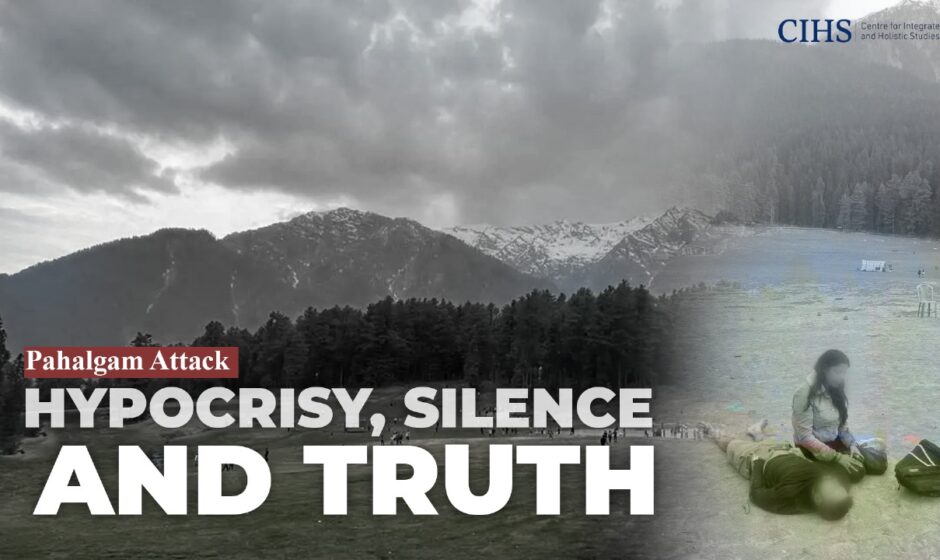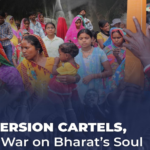Rohan Giri
On April 22, 2025, tourist destination of Pahalgam in Jammu and Kashmir, bore witness to an atrocity that defies human conscience. In a brutal terrorist attack orchestrated by Pakistan-backed terrorist groups, 26 Hindu tourists were singled out based on their faith and mercilessly executed. Their only ‘crime’ was being Hindu.

Global media outlets rushed to distort the truth rather than mourning the victims or condemning the clear religious hatred behind the massacre. Reuters, BBC, New York Times, Al Jazeera, CNN, and others showcased once again the alarming moral bankruptcy within sections of international journalism deliberately downplaying religious targeting, sanitizing terrorists as “militants,” and portraying the blood-soaked valley through the lens of “Indian-administered Kashmir,” thus questioning India’s very sovereignty.
This selective empathy, this sanitized barbarism, this intellectual dishonesty stands exposed.
Pahalgam attack was not an isolated incident. It was the continuation of an ideological war against India’s civilizational essence. Pakistan’s military leadership has been candid about this.
At the passing-out parade on April 16, 2025, at Pakistan Military Academy, Kakul, Pakistan’s Chief of Army Staff General Asim Munir brazenly declared:
“The two-nation theory was based on the fundamental belief that Muslims and Hindus are two separate nations, not one. Muslims are distinct from Hindus in all aspects of life, religion, customs, traditions, thinking, and aspirations.”
This ideological rigidity the very cancer that partitioned the Indian subcontinent continues to fuel terrorism, hatred, and separatism even today. Munir’s public reaffirmation of the two-nation theory is not just a historical reference; it is an active justification for ongoing violence in Kashmir.
In parallel, at a rally organized by Lashkar-e-Taiba in Rawalkot on April 18, 2025, to pay tribute to two terrorists, Akif Haleem and Abdul Wahab, JKUM/LeT commander Abu Musa threatened openly:
“Jihad will continue, guns will rage, and beheading will continue in Kashmir. India wants to change the demography of Kashmir by giving domicile certificates to non-locals, and we will not let this happen.”
Such public incitements to murder, terrorism, and ethnic cleansing are treated by Western media either as footnotes or are conveniently omitted altogether.
The narrative of “demographic change” itself is a cruel inversion of reality.
The so-called “domicile certificates” that the Government of India grants are not tools of colonization, but instruments of justice, meant to reintegrate indigenous Hindu communities
Kashmir is not a no-man’s land. It is the ancient land of Kashyap Rishi, one of the holiest sites of the Indic civilization. Restoration of native communities into their rightful homeland is a moral imperative, not an act of aggression.
The Hindu American Foundation (HAF) issued a scathing critique of international media complicity.
In a powerful statement, HAF’s Executive Director summarized the media betrayal:
“On April 22, 2025, the worst civilian terror attack in Kashmir since 2008 unfolded. 26 Hindu tourists were executed. Yet if you look at headlines from New York Times, Washington Post, CNN, BBC, Reuters, and AP you wouldn’t even know Hindus were targeted.
They downplay terrorism. Sanitize it. Hide the victims’ religious identities. Call terrorists ‘militants.’ This isn’t just tragic storytelling, it’s deliberate erasure.”
This is not a mere reporting error. It is a systemic ideological bias that minimizes Hindu suffering and perpetuates anti-India stereotypes under the garb of neutrality.
Terms like “Indian-administered Kashmir,” “militants,” and “tensions” dilute the reality of Pakistan-sponsored jihadist terror and instead, subtly vilify the Indian state.
Would any Western media outlet ever call ISIS terrorists “militants”? Would they ever describe 9/11 attackers as “gunmen”?
Why then, when Hindu civilians are massacred, do standards suddenly change?
The answer lies in a toxic cocktail of post-colonial condescension, ideological ignorance, and sheer intellectual dishonesty.
This time, however, the narrative war met fierce resistance.
The global Indian diaspora an economic, academic, and cultural powerhouse rose in unprecedented solidarity.
From Federation Square in Melbourne to Pakistan High Commission in London, from Copenhagen to Kathmandu, from Paris to Zurich to Helsinki, and across North America from Brampton to New York, Indians staged massive protests demanding justice for the victims.
In Frankfurt, more than 300 Indian community members gathered at Central Railway Station, marching to Dom Romer, holding placards, chanting slogans against terrorism, and sending a strong message to the global conscience: Truth will not be silenced.
This global mobilization was not spontaneous rage it was righteous anger forged over decades of media erasure, diplomatic duplicity, and institutional gaslighting.
Indian expatriates—scientists, CEOs, artists, and teachers have realized that silence only emboldens lies.
From Zurich to Auckland, their unified cry reverberated: Stop justifying terror. Stop dehumanizing Hindu victims.
Kashmir must be understood not as a “disputed territory” between two states but as a living civilizational landscape.
It is a land where Adi Shankaracharya revived Sanatana Dharma atop the Shankaracharya Hill, where Shaivism blossomed into philosophical sophistication, where Sufi saints preached syncretism. It is not a medieval battleground between empires but an eternal testimony to India’s pluralistic ethos.
The terror attacks and false narratives seek to destroy this rich civilizational memory. And that is precisely why India’s actions to secure, stabilize, and culturally revive Jammu and Kashmir are not just acts of national policy but acts of civilizational preservation.
Every attempt to portray Jammu and Kashmir as “disputed,” every attempt to vilify the domiciles, is an assault on truth itself.
Domicile for those historically belonging to Kashmir is not “changing demography” it is correcting injustice.
Pakistan’s rhetoric about demography rings hollow in contrast to its own colonization of Gilgit-Baltistan, its demographic suppression of Balochistan, and its apartheid-like persecution of minorities.
It’s time the world recognises this double standard.
It is time for India to call out, with measured but firm diplomacy, the duplicity of global actors.
- International media must stop being echo chambers for terrorist sympathisers.
- Global academic institutions must cease patronising narratives that excuse terrorism under the romantic guise of “freedom struggle.”
- Pakistan must be held accountable for every drop of blood spilled by its terror proxies.
- China must be exposed for its opportunistic partnership in disseminating disinformation.
- And above all, Hinduphobia, devaluation of Hindu suffering, must be recognised and challenged, just as Islamophobia, anti-Semitism, and other forms of hate are.
Global Indian community’s anger is righteous. It is not the anger of vengeance, but of justice denied, victims forgotten, and narratives hijacked.
The world ignored exodus in 1990 when Hindus were driven out in hundreds of thousands from their homes, Wandhama Massacre, Sikh Massacre in Chattisinghpora to name a few. It must not ignore Pahalgam 2025. History will not be kind to those who remained silent or distorted the truth when confronted with naked evil.
India, ancient yet ever-renewing, will endure. Its voice, amplified by a billion at home and millions abroad, will be heard.
And the truth about Kashmir Kashyap’s Kashmir—will ultimately prevail over the lies spun in dark rooms of propaganda.
(Author is a doctoral fellow at Amity University in Gwalior, content head at Centre for Integrated and Holistic Studies)



